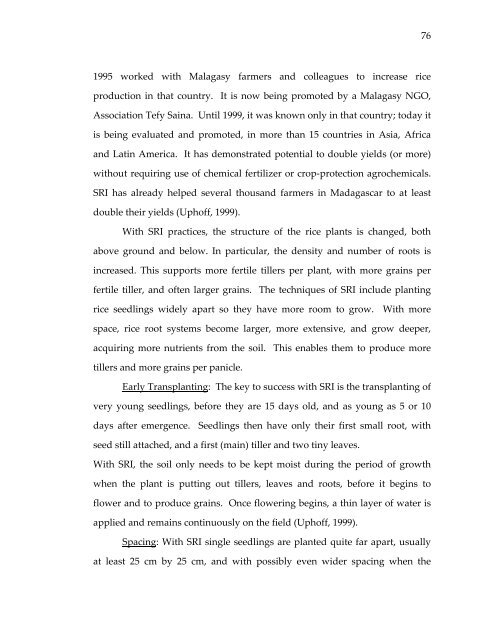Management of rice production systems to increase productivity
Management of rice production systems to increase productivity
Management of rice production systems to increase productivity
You also want an ePaper? Increase the reach of your titles
YUMPU automatically turns print PDFs into web optimized ePapers that Google loves.
1995 worked with Malagasy farmers and colleagues <strong>to</strong> <strong>increase</strong> <strong>rice</strong><br />
<strong>production</strong> in that country. It is now being promoted by a Malagasy NGO,<br />
Association Tefy Saina. Until 1999, it was known only in that country; <strong>to</strong>day it<br />
is being evaluated and promoted, in more than 15 countries in Asia, Africa<br />
and Latin America. It has demonstrated potential <strong>to</strong> double yields (or more)<br />
without requiring use <strong>of</strong> chemical fertilizer or crop‐protection agrochemicals.<br />
SRI has already helped several thousand farmers in Madagascar <strong>to</strong> at least<br />
double their yields (Uph<strong>of</strong>f, 1999).<br />
With SRI practices, the structure <strong>of</strong> the <strong>rice</strong> plants is changed, both<br />
above ground and below. In particular, the density and number <strong>of</strong> roots is<br />
<strong>increase</strong>d. This supports more fertile tillers per plant, with more grains per<br />
fertile tiller, and <strong>of</strong>ten larger grains. The techniques <strong>of</strong> SRI include planting<br />
<strong>rice</strong> seedlings widely apart so they have more room <strong>to</strong> grow. With more<br />
space, <strong>rice</strong> root <strong>systems</strong> become larger, more extensive, and grow deeper,<br />
acquiring more nutrients from the soil. This enables them <strong>to</strong> produce more<br />
tillers and more grains per panicle.<br />
Early Transplanting: The key <strong>to</strong> success with SRI is the transplanting <strong>of</strong><br />
very young seedlings, before they are 15 days old, and as young as 5 or 10<br />
days after emergence. Seedlings then have only their first small root, with<br />
seed still attached, and a first (main) tiller and two tiny leaves.<br />
With SRI, the soil only needs <strong>to</strong> be kept moist during the period <strong>of</strong> growth<br />
when the plant is putting out tillers, leaves and roots, before it begins <strong>to</strong><br />
flower and <strong>to</strong> produce grains. Once flowering begins, a thin layer <strong>of</strong> water is<br />
applied and remains continuously on the field (Uph<strong>of</strong>f, 1999).<br />
Spacing: With SRI single seedlings are planted quite far apart, usually<br />
at least 25 cm by 25 cm, and with possibly even wider spacing when the<br />
76
















